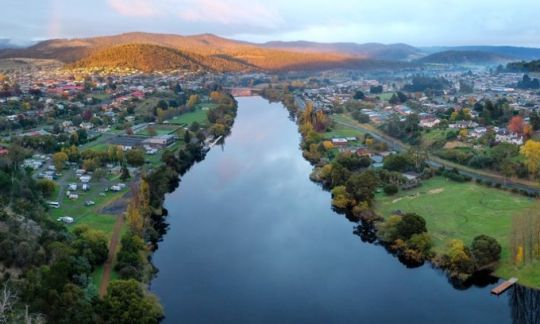5 best suburbs in Regional Tasmania to invest in 2025
Looking to buy a property in Tasmania? These are the 5 best suburbs in Tasmania to invest in for 2025, based on overall market performance.

Looking to buy a property in Tasmania? These are the 5 best suburbs in Tasmania to invest in for 2025, based on overall market performance.
KEY POINTS
- Recent sales activity and low vacancy rates could see property performance improve in regional Tasmania in 2025.
- Regional areas of Tasmania are no longer a bargain hunter’s paradise they once were, though they remain relatively affordable.
- After two years of stagnation, areas such as Launceston are poised for a new growth phase.
Property growth in regional Tasmania struggled in 2024, but has recently seen some solid sales activity. Combined with low vacancy rates, this could translate into stronger performance in 2025.
Similarly to Hobart, regional Tasmania enjoyed exceptional price rises in previous years thanks to the national trend of big city residents moving to regional areas to find a more relaxed and affordable lifestyle. These areas are still relatively affordable, but are no longer a bargain hunter’s paradise, with the market flat-lining over 2024 with only moderate growth.
Even Launceston, Tasmania’s second city and the target for many buyers during the state’s boom, is no longer such an affordable market. That said, it continues to attract new residents and interstate investors, and is poised for another growth phase after two years of stagnation.
Regional Tasmania now stands roughly equivalent to regional Western Australia or regional Victoria in terms of house prices. Though in terms of sales volumes, regional Tasmania is now doing about as well as regional Queensland, with half of its locations displaying positive trends.
The data below was prepared in February 2025 with suburb median prices, growth rates, vacancy rates and median rental yields provided by Hotspotting by Ryder and initial outlay and monthly repayments calculated by Canstar Research.
Top 5 best suburbs in Tasmania to invest in 2025
- Acton
- Devonport
- Norwood
- Primrose Sands
- Ravenswood
Acton
The Burnie suburb of Acton is popular for its affordability and amenity, with THE Burnie LGA overall a key regional centre for Tasmania. Featuring one of the state’s top export ports in its north, as well as considerable public and private investment, it has a strong capital growth record; thanks in part to vacancies at zero and rents having risen almost 10% over the past 12 months.
Devonport
The northern centre of Devonport is the base for the ferries that connect Tasmania with Melbourne. Its housing market is experiencing a second wind, having experienced strong growth between 2020 and 2022, flatlining for two years, then rising again. Both houses and units have recorded median price growth in the past year, against the state trend of minor price decline.
Norwood
Buyer demand is rising in the suburb of Norwood, about 5km south-east of Launceston city centre—and in turn, prices are starting to react. The suburb has seen a five-year capital growth average of 10% a year, and vacancies are below 1%. Norwood is surrounded by major parks and reserves, and there are a number of schools in the area.
Primrose Sands
The Sorell municipality provides some affordable lifestyle alternatives to nearby Hobart. This includes bayside Primrose Sands, where prices are starting to rise again after a two-year pause following the 2020-2022 boom. There is also good demand from tenants, with rents rising almost 10% in the past 12 months.
Ravenswood
Ravenswood, on the eastern fringe of Launceston, is surrounded by forest reserves and has a primary school and a supermarket. Prices are starting to rise again in this affordable suburb, with an 8% increase in the past year. Despite this, and a five-year growth average of 13% a year, the median house price remains well below $400,000. The suburb also has the highest rental yields in the city, with a median of 6.6%.
The comparison rate for all home loans and loans secured against real property are based on secured credit of $150,000 and a term of 25 years.
^WARNING: This comparison rate is true only for the examples given and may not include all fees and charges. Different terms, fees or other loan amounts might result in a different comparison rate.
 Owner occupied
Owner occupied
 20% min deposit
20% min deposit
 Redraw facility
Redraw facility
Canstar may earn a fee for referrals from its website tables, and from Sponsorship or Promotion of certain products. Fees payable by product providers for referrals and Sponsorship or Promotion may vary between providers, website position, and revenue model. Sponsorship or Promotion fees may be higher than referral fees. Sponsored or Promoted products are clearly disclosed as such on website pages. They may appear in a number of areas of the website such as in comparison tables, on hub pages and in articles. Sponsored or Promoted products may be displayed in a fixed position in a table, regardless of the product’s rating, price or other attributes. The table position of a Sponsored or Promoted product does not indicate any ranking or rating by Canstar. For more information please see How We Get Paid.
Best suburbs in Tasmania to invest 2025
← Mobile/tablet users, scroll sideways to view full table →
| Suburb | Median price |
1-year growth (p.a %) |
10-yr average annual growth (p.a %) |
Vacancy Rate |
Median Rental Yield (p.a %) |
Initial outlay (no concessions) on 20% deposit |
Monthly Repayment |
|---|---|---|---|---|---|---|---|
| Acton | $355,000 | 1% | 14% | 0.00% | 5.70% | $83,540 | $1,739 |
| Devonport | $475,000 | 4% | 11% | 0.50% | 5.00% | $112,590 | $2,327 |
| Norwood | $610,000 | 5% | 10% | 0.80% | 4.60% | $145,328 | $2,989 |
| Primrose Sands | $480,000 | 1% | 13% | 1.60% | 4.30% | $113,803 | $2,352 |
| Ravenswood | $370,000 | 8% | 13% | 1.10% | 6.60% | $87,140 | $1,813 |
Source: www.canstar.com.au. Prepared in February 2025. Based on a selection of suburbs’ median prices, growth and rent figures provided by Hotspotting by Ryder. Initial outlay figures include the deposit, stamp duty, mortgage registration and transfer fees; and lenders’ mortgage insurance (LMI) premium for the 10% deposit scenarios. Stamp duty calculated based on an owner occupier purchase of an established dwelling where applicable. FHB concessions include stamp duty only. LMI premium based on Helia LMI Premium Calculator for an owner occupier borrower and a loan term of 30 years. Monthly repayments calculated based on the interest rates of 6.20% (20% deposit) and 6.34% (10% deposit) and a loan term of 30 years. Interest rates based on the RBA Lenders’ Interest Rates (November 2024). Percentage of income based on the average total income by Greater Capital City Statistical Area (ABS Personal Income, 2021-22), adjusted by the ABS Wage Price Index (Sep-2024) for each state.
What are some of the factors affecting the regional Tasmania market?
Sales volumes
Sales activity peaked in Tasmania around 2021-22 and has been fairly moderate since. However, half of the locations in regional Tasmania are now displaying positive sales volume trends, roughly equivalent to regional Queensland.
Quarterly price growth
The recent elevation in sales may point to better outcomes on prices in 2025, but it wasn’t yet evident in the November quarter, with just 25% of locations delivering good price uplift.
Vacancy rates
Regional Tasmanian locations with vacancy rates below 1% increased from around 40% to around 57% over the past year.
Rental growth
Regional Tasmania is similar to Hobart in that it has experienced strong performance on vacancy rates but a weak outcome on rental growth. The reasons behind it are also similar—the capacity of the local market to pay higher rents after several years of big growth is limited, especially in the state with some of the lowest incomes in the nation.
Infrastructure spending
There is only moderate investment in infrastructure projects in regional Tasmania. However, the state’s economic and property prospects could improve in the future, with $10 billion in developments in planning.
The comparison rate for all home loans and loans secured against real property are based on secured credit of $150,000 and a term of 25 years.
^WARNING: This comparison rate is true only for the examples given and may not include all fees and charges. Different terms, fees or other loan amounts might result in a different comparison rate.

Up to $4,000 when you take out a IMB home loan. Minimum loan amounts and LVR restrictions apply. Offer available until further notice. See provider website for full details. Exclusions, terms and conditions apply.
 Owner occupied
Owner occupied
 20% min deposit
20% min deposit
 Redraw facility
Redraw facility
 Owner occupied
Owner occupied
 20% min deposit
20% min deposit
 Redraw facility
Redraw facility
 Owner occupied
Owner occupied
 30% min deposit
30% min deposit
 Redraw facility
Redraw facility
 Owner occupied
Owner occupied
 30% min deposit
30% min deposit
 Redraw facility
Redraw facility
Canstar may earn a fee for referrals from its website tables, and from Sponsorship or Promotion of certain products. Fees payable by product providers for referrals and Sponsorship or Promotion may vary between providers, website position, and revenue model. Sponsorship or Promotion fees may be higher than referral fees. Sponsored or Promoted products are clearly disclosed as such on website pages. They may appear in a number of areas of the website such as in comparison tables, on hub pages and in articles. Sponsored or Promoted products may be displayed in a fixed position in a table, regardless of the product’s rating, price or other attributes. The table position of a Sponsored or Promoted product does not indicate any ranking or rating by Canstar. For more information please see How We Get Paid.
Cover image source: Wirestock Creators/Shutterstock.com
This article was reviewed by our Finance Editor Jessica Pridmore before it was updated, as part of our fact-checking process.

Mark has been a journalist and writer in the financial space for over ten years, previously researching and writing commercial real estate at CoreLogic. In the years since, Mark has worked for the Winning Group, Expedia, and has seen articles published at Lifehacker and Business Insider.
Mark has also completed RG 146 (Tier 1), making him compliant to provide general advice for general insurance products like car, home, travel and health insurance, as well as giving him knowledge of investment options such as shares, derivatives, futures, managed investments, currencies and commodities. Find Mark on Linkedin.
The comparison rate for all home loans and loans secured against real property are based on secured credit of $150,000 and a term of 25 years.
^WARNING: This comparison rate is true only for the examples given and may not include all fees and charges. Different terms, fees or other loan amounts might result in a different comparison rate.

Up to $4,000 when you take out a IMB home loan. Minimum loan amounts and LVR restrictions apply. Offer available until further notice. See provider website for full details. Exclusions, terms and conditions apply.
 Owner occupied
Owner occupied
 20% min deposit
20% min deposit
 Redraw facility
Redraw facility
Try our Home Loans comparison tool to instantly compare Canstar expert rated options.
The comparison rate for all home loans and loans secured against real property are based on secured credit of $150,000 and a term of 25 years.
^WARNING: This comparison rate is true only for the examples given and may not include all fees and charges. Different terms, fees or other loan amounts might result in a different comparison rate.





